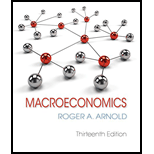
Macroeconomics
13th Edition
ISBN: 9781337617390
Author: Roger A. Arnold
Publisher: Cengage Learning
expand_more
expand_more
format_list_bulleted
Question
Chapter 13, Problem 9WNG
To determine
The change in money supply.
Expert Solution & Answer
Trending nowThis is a popular solution!

Students have asked these similar questions
Only human experts solved it. Direction: Do a total of 5 of this, instruction and the topic is provided in the picture. Strictly write this in bond paper.
NOTE: strictly use nautical almanac. This is about maritime navigation.
not use ai please
Use the following table to work Problems 5 to 9.
Minnie's Mineral Springs, a single-price monopoly,
faces the market demand schedule:
Price
Quantity demanded
(dollars per bottle)
10
8
(bottles per hour)
0
1
6
2
4
3
2
4
0
5
5. a. Calculate Minnie's total revenue schedule.
b. Calculate its marginal revenue schedule.
6. a. Draw a graph of the market demand curve
and Minnie's marginal revenue curve.
b. Why is Minnie's marginal revenue less than
the price?
7. a. At what price is Minnie's total revenue maxi-
mized?
b. Over what range of prices is the demand for
water from Minnie's Mineral Springs elastic?
8. Why will Minnie not produce a quantity at which
the market demand for water is inelastic?
Chapter 13 Solutions
Macroeconomics
Ch. 13.1 - Prob. 1STCh. 13.1 - Prob. 2STCh. 13.1 - Prob. 3STCh. 13.3 - Prob. 1STCh. 13.3 - Prob. 2STCh. 13.3 - Prob. 3STCh. 13.3 - Prob. 4STCh. 13 - Prob. 1QPCh. 13 - Prob. 2QPCh. 13 - Prob. 3QP
Ch. 13 - Prob. 4QPCh. 13 - Prob. 5QPCh. 13 - Prob. 6QPCh. 13 - Prob. 7QPCh. 13 - Prob. 8QPCh. 13 - Prob. 9QPCh. 13 - Prob. 10QPCh. 13 - Prob. 11QPCh. 13 - Prob. 12QPCh. 13 - Prob. 1WNGCh. 13 - Prob. 2WNGCh. 13 - Prob. 3WNGCh. 13 - Prob. 4WNGCh. 13 - Prob. 5WNGCh. 13 - Prob. 6WNGCh. 13 - Prob. 7WNGCh. 13 - Prob. 8WNGCh. 13 - Prob. 9WNGCh. 13 - Prob. 10WNG
Knowledge Booster
Similar questions
- Not use ai pleasearrow_forwardThe Firm's Output Decision (Study Plan 12.2) Use the following table to work Problems 4 to 6. Pat's Pizza Kitchen is a price taker. Its costs are Output (pizzas per hour) Total cost (dollars per hour) 0 10 1 21 2 30 3 41 4 54 5 69 4. Calculate Pat's profit-maximizing output and economic profit if the market price is (i) $14 a pizza. (ii) $12 a pizza. (iii) $10 a pizza. 5. What is Pat's shutdown point and what is Pat's economic profit if it shuts down temporarily? 6. Derive Pat's supply curve.arrow_forwardUse the following table to work Problems 27 and 28. ProPainters hires students at $250 a week to paint houses. It leases equipment at $500 a week. The table sets out its total product schedule. Labor (students) 1 Output (houses painted per week) 2 23 5 3 9 4 12 5 14 6 15 27. If ProPainters paints 12 houses a week, calculate its total cost, average total cost, and marginal cost. At what output is average total cost a minimum? 28. Explain why the gap between ProPainters' total cost and total variable cost is the same no matter how many houses are painted.arrow_forward
- Use the following table to work Problems 17 to 20. The table shows the production function of Jackie's Canoe Rides. Labor Output (rides per day) (workers per day) Plant 1 Plant 2 Plant 3 Plant 4 10 20 40 55 65 20 40 60 75 85 30 65 75 90 100 40 75 85 100 110 Canoes 10 20 30 40 Jackie's pays $100 a day for each canoe it rents and $50 a day for each canoe operator it hires. 19. a. On Jackie's LRAC curve, what is the average cost of producing 40, 75, and 85 rides a week? b. What is Jackie's minimum efficient scale?arrow_forwardPlease solve this questions step by step handwritten solution and do not use ai thank youarrow_forwardPlease solve questions 3 and 4 step by step handwritten solution and no ai toolsarrow_forward
- Please solve questions 1 and 2 step by step handwritten solution and no ai toolsarrow_forwardNot use ai pleasearrow_forward1. Riaz has a limited income and consumes only Apple and Bread. His current consumption choice is 3 apples and 5 bread. The price of apple is $3 each, and the price of bread is $2.5 each. The last apple added 5 units to Sadid's utility, while the last bread added 7 units. Is Riaz making the utility-maximizing choice? Why or why not? Do you suggest any adjustment in Riaz's consumption bundle? Why or why not? Give reasons in support of your answer. State the condition for a consumer's utility maximizing choice and illustrate graphically. 2. Consider the following table of long-run total costs for three different firms: Quantity Total Cost ($) Firm A Firm B Firm C 1 60 11 21 2 70 24 34 3 80 39 49 4 90 56 66 5 100 75 85 6 110 96 106 7 120 119 129 Does each of these firms experience economies of scale or diseconomies of scale? Explain your answer with necessary calculations.arrow_forward
arrow_back_ios
SEE MORE QUESTIONS
arrow_forward_ios
Recommended textbooks for you
 Economics (MindTap Course List)EconomicsISBN:9781337617383Author:Roger A. ArnoldPublisher:Cengage Learning
Economics (MindTap Course List)EconomicsISBN:9781337617383Author:Roger A. ArnoldPublisher:Cengage Learning
 Exploring EconomicsEconomicsISBN:9781544336329Author:Robert L. SextonPublisher:SAGE Publications, Inc
Exploring EconomicsEconomicsISBN:9781544336329Author:Robert L. SextonPublisher:SAGE Publications, Inc



Economics (MindTap Course List)
Economics
ISBN:9781337617383
Author:Roger A. Arnold
Publisher:Cengage Learning


Exploring Economics
Economics
ISBN:9781544336329
Author:Robert L. Sexton
Publisher:SAGE Publications, Inc


